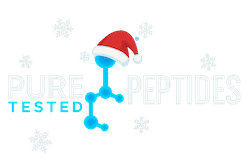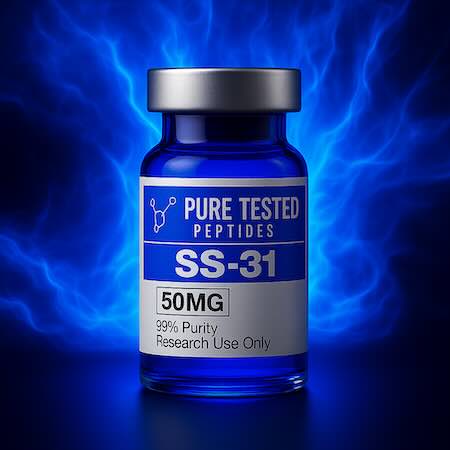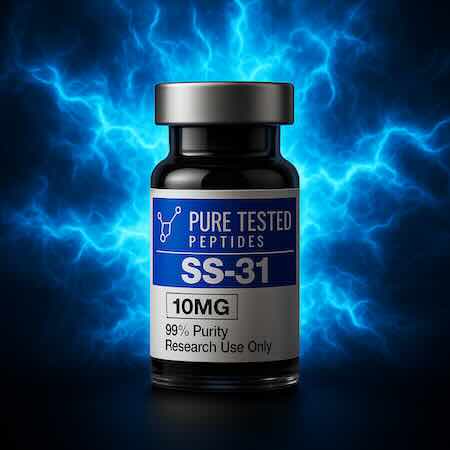SS-31 (also referenced as elamipretide; a Szeto–Schiller peptide) is a mitochondria-targeted tetrapeptide studied for its interaction with cardiolipin and potential to influence electron transport efficiency, membrane potential, and redox balance in diverse research models. This page is written for laboratories and investigators; it makes no therapeutic claims.
SS-31 Research: Mechanism, Bioenergetic Implications, and Study Endpoints
What is SS-31? SS-31 is a cationic, aromatic tetrapeptide designed to preferentially localize to the inner mitochondrial membrane. Its affinity for cardiolipin—a signature phospholipid that scaffolds respiratory complexes—has motivated studies exploring whether SS-31 can stabilize electron transport chain (ETC) supercomplex organization, support mitochondrial membrane potential (ΔΨm), and modulate reactive oxygen species (ROS) production under metabolic stress. Because mitochondrial bioenergetics intersect with cellular maintenance pathways, SS-31 has been investigated in models of ischemia-reperfusion, skeletal muscle fatigue, neuro-retinal stress, and age-associated bioenergetic decline, among others. Terminology such as “SS-31 10mg,” “buy pure SS-31 50mg,” “buy SS31 online,” and “buy SS31 peptide” often appears in methods or procurement notes solely to ensure SKU clarity and source reproducibility for COA-linked lots.
Why mitochondria and cardiolipin? Cardiolipin helps maintain the structural and functional integrity of Complexes I–IV and V, influences cristae curvature, and anchors cytochrome c. Oxidative remodeling of cardiolipin can impair ETC efficiency and amplify ROS. SS-31’s research significance centers on its ability to associate with cardiolipin-rich regions, where it has been studied for effects on cytochrome c peroxidase activity, electron flux, and proton leak. Investigators frequently evaluate whether these biophysical interactions translate into measurable changes in ATP synthesis rates, ROS indices, and downstream signaling (e.g., AMPK activation profiles) across tissue types.
Common endpoints. To contextualize SS-31’s effects, research designs often quantify: (1) oxygen consumption rate (OCR) and spare respiratory capacity; (2) ΔΨm stability (e.g., potentiometric dyes); (3) ROS markers (MitoSOX or equivalent); (4) ETC complex activity assays; (5) mitochondrial morphology (cristae ultrastructure via EM) and mitophagy/autophagy markers; and (6) functional readouts relevant to the model (e.g., fatigue resistance in myofibers or retinal electrophysiology parameters). Because bioenergetic profiles vary by tissue, rigorous controls—time-of-day sampling, temperature, substrate availability, and blinding—are essential for credible effect attribution. Many groups also report exploratory translational markers while maintaining a strict preclinical framing aligned with Buy pure peptides for longevity research themes (without implying human use).
For researchers indexing inventory and COAs by vial content, a convenient listing is
SS-31 10 mg (product page).
Mechanistic Highlights
Cardiolipin association and electron flux. SS-31’s amphipathic design facilitates electrostatic and hydrophobic interactions with cardiolipin domains. In multiple models, this association is studied for its potential to stabilize cytochrome c and reduce peroxidase activity, thereby favoring electron transfer over ROS generation. Investigators frequently assess whether SS-31 shifts respiration toward higher coupling efficiency (ATP/O ratio) and mitigates state-4 respiration elevations under stress.
Mitochondrial membrane potential (ΔΨm) and cristae integrity. ΔΨm is a central driver of ATP synthase. Research often tests whether SS-31 preserves ΔΨm during acute stress and whether cristae morphology is maintained—both of which can impact peak ATP output and resilience to metabolic perturbations. Complementary endpoints include mitochondrial swelling assays, cardiolipin oxidation status, and electron micrographs that quantify cristae density.
Redox balance and signaling. Lowering pathological ROS can secondarily influence redox-sensitive pathways (e.g., NRF2 target expression). Accordingly, studies may include glutathione ratios (GSH/GSSG), lipid peroxidation products, and protein carbonylation panels. Because ROS also serve as signals, protocols distinguish between baseline physiologic ROS and stress-induced bursts, ensuring interpretations focus on maladaptive oxidation rather than total ROS suppression.
Tissue-specific considerations. High-energy tissues—cardiac, skeletal muscle, brain/retina, and renal proximal tubules—show distinct substrate preferences and ETC bottlenecks. SS-31 research often tailors substrate cocktails (pyruvate/malate vs. succinate/rotenone) and workload paradigms (electrical field stimulation in myotubes; light stress in retinal explants) to reflect real-world energetic challenges. Downstream functional readouts, such as force generation or electrophysiologic responsiveness, lend translational context while remaining firmly preclinical.
For protocols that log lot numbers by higher vial content SKUs for extended series, investigators sometimes cite
SS-31 50 mg (product page)
to maintain clarity in LIMS and audit trails.
Designing Robust SS-31 Studies
Controls & comparators. Robust designs include vehicle controls, oxidative stress inducers (e.g., antimycin A, t-BHP) where appropriate, and known modulators (positive/negative controls) to benchmark effect sizes. Time-matched sampling is critical because circadian influences alter mitochondrial outputs. Where model-specific confounders exist (e.g., media composition, serum factors), pre-registration and predefined exclusion criteria help maintain interpretability.
Assay selection. Because mitochondrial outcomes are multifactorial, single readouts rarely suffice. A balanced panel—OCR/ECAR profiling, ETC complex assays, ΔΨm, ROS indices, and structural endpoints—can reveal whether observed changes reflect genuine improvements in coupling vs. artifacts (e.g., non-specific antioxidant effects). Reporting raw traces, normalization strategies (per cell, per protein, citrate synthase activity), and calibration details improves cross-lab reproducibility.
Data interpretation. Increases in ATP output with concurrent reductions in pathological ROS strengthen the case for improved coupling. However, elevated OCR alone may indicate futile cycling; pairing OCR with ATP measurements and proton leak estimates distinguishes beneficial from neutral/negative shifts. Likewise, improvements in a single tissue should not be generalized without replication across models and workloads.
Procurement transparency. To support replication, many methods sections include supplier URLs, COAs, and SKU slugs. Phrases like “Buy SS31,” “buy SS31 online,” and “Buy pure peptides for longevity” may appear strictly as catalog anchors—not as usage advice or health claims. All materials referenced here are intended for laboratory research only and are not for human consumption.
For site-wide information about quality controls (HPLC, mass spectrometry) and fulfillment, see
PureTestedPeptides.com.
Key Takeaways
- Target: SS-31 associates with cardiolipin in the inner mitochondrial membrane.
- Focus: Studies examine ETC efficiency, ΔΨm stability, ROS modulation, and tissue-specific function.
- Rigor: Use multi-modal assays and pre-specified analysis plans to avoid over-interpreting single endpoints.
- SEO notes included: “SS-31,” “SS-31 10mg,” “buy pure SS-31 50mg,” “buy SS31 online,” “buy SS31 peptide,” “Buy SS31,” and “Buy pure peptides for longevity” are present for indexability in research contexts.
FAQ (Research Context)
What distinguishes SS-31 from broad antioxidants?
SS-31 localizes to cardiolipin-rich inner mitochondrial membranes, where it is studied for effects on ETC coupling, ΔΨm, and cytochrome c peroxidase activity—mechanisms more targeted than generalized redox scavenging.
Which readouts best capture SS-31’s mitochondrial effects?
A combination of OCR/ATP coupling metrics, ΔΨm stability, ROS indices, and structural assays (e.g., cristae integrity) provides a credible, multi-angle view.
How should procurement be recorded?
Include supplier URLs, lot numbers, and COAs in methods. Inventory phrases like SS-31 10mg and buy pure SS-31 50mg can be included as SKU anchors for replication.


